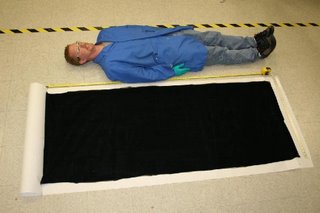March 29, 2008
Over at Colony Worlds, Darnell Clayton wonders if the inflatable Spacehab type modules that Bigelow Aerospace are using can be adapted to artificial gravity.
 Now, one of the Brickmuppets crack team of science babes points out that, somewhat surprisingly, the numbers have already been run on this idea and it is quite doable.
Now, one of the Brickmuppets crack team of science babes points out that, somewhat surprisingly, the numbers have already been run on this idea and it is quite doable.
The study, in pdf form here, is quite interesting and relevant to human exploration in ways that the ISS simply is not.
Designed as an exercise by a team of students from the University of Maryland (at College Park) the proposed Clarke Station is a manned, variable gravity research facility intended to determine exactly what gravity level is needed to sustain long term human health.
Given that all of the planets and moons with resources that make human settlement possible have substantially less gravity than Earth, this is a nontrivial question. Lunar Gravity can, of course, be tested on an off the shelf satellite...the moon...but it seems prudent to test physiological effects of other gravities at a location no farther than the moon where the bail and scramble back to earth time is measured in days not months (or years in the case of Titan). A variable gravity facility can of course be used for training in say, Martian gravity to learn any tricks and unwelcome surprises of a particular gravity level. It bears remembering that the 1/6th gravity of the moon required some considerable adaptation by the Apollo Astronauts to simply get around.
(boingy boingy boingy..)
We need to find out some very basic things....
Does gravity in the ballpark of the moon have the same long term effects as 0 gravity? If so, what is the lower limit of tolerable gravity? Can we have permanent settlements on the 1/4 g environment of Mars for instance? Can low gravity effects be mitigated by exercise or drugs in ways that actual free-fall cannot? (this seems likely....to a point....but we have no reference for where that point might be). What are the actual maximum rotation rates that a crew can reasonably adapt to? This has a big effect on how wide and therefore big and heavy the centrifuge habitat in a spacecraft needs to be I've see reports that suggest a 30 foot diameter is adequate (Zubrin referring to his Gaiashield mission) and some that say 100 feet or more is necessary....we need to KNOW this stuff.
None of this can be found out on the ISS or current spacecraft because they are in free fall. A proposed gravity deck on the ISS was omited for budgetary reasons (and I'm not sure it would have been useable by people). Manned space exploration is going to require these sorts of questions answered
The station is interesting for another reason. Its choice of radiation protection.
The station is positioned at a Lagrange point (L1) which leaves the crew without the protection of the Van-Allen belts. This is compensated for by filling the walls of the inflatable modules with water. A few trips will pump the water into the walls to give superb protection. The original NASA inflatable concepts (going back to the 80's) had this as a feature so it is well within the design parameters of the materials involved. Water is heavy, but it is easy to handle and is well tested as a radiation shield. Given the existence of an inflatable module, pumping in water is just one more thing that needs to be pumped, simplifying assembly. Outside cislunar space on a mission to another planet or an asteroid, this sort of rad shielding will be a real asset. This is not a new concept at all, and it is elegant in its simplicity but it has never actually been done.
The position of this station at a liberation point is of more significance now than it was when this plan was developed, as we now have as a national goal a return to the moon. As John Goff points out, orbital propellant depots at a Lagrange point have the double advantage of enabling greater payloads to be carried to the moon and learning important, practical hands on lessons about one of the primary technologies for spacefaring....transfering fuel and other fluids between spacecraft. More on this architecture here and here is Boeing's proposal, focusing not just on the nuts and bolts but its commercial viability...in this case of a low earth orbit facility. Things break, so if an orbital propellant depot is built having one of these nearby allows the crew to do double duty as gas station attendants! ![]()
It should be noted that the Bigelow-type inflatables are a fairly mature technology,for instance, here is a paper on inflatables from 1988.
Within the limits imposed by my stock disclaimer, this station seems to be a conservative and robust in design with a good fudge factor regards strength (it can sustain 1.2G) and the inflatable modules should simplify construction. It is a modest near term proposal using off the shelf technology that can bring in huge benefits There are certainly some issues not covered by these engineering students but in order to tweak those would only require NASA to send it to Langley or Glenn. All that would require would be for NASA to be looking seriously at this line of research.
And therein lies the rub.....
Science babe is from Intron Depot (I think) and is, of course, by Masamune Shirow, who's art, books and artbooks can be bought here.
Posted by: The Brickmuppet at
10:40 PM
| Comments (1)
| Add Comment
Post contains 915 words, total size 7 kb.
March 04, 2008
Chun-Li turned 40 on Saturday! ![]()

Posted by: The Brickmuppet at
09:46 AM
| No Comments
| Add Comment
Post contains 8 words, total size 1 kb.
Wow!
Popular Mechanics provides these pictures of two massive Martian avalanches, taken from orbit.
Posted by: The Brickmuppet at
09:46 AM
| No Comments
| Add Comment
Post contains 16 words, total size 1 kb.
March 02, 2008
One of the Brickmuppet's crack team of science babes would seem to be all dressed up with nowhere to go, but in fact is trying out her new threads around 4 years in advance... in anticipation of this rather speculative story from Flight Global panning out.
dressed up with nowhere to go, but in fact is trying out her new threads around 4 years in advance... in anticipation of this rather speculative story from Flight Global panning out.
It seems that the next step in the Virgin Galactic/ Scaled Composites spacecraft evolution is thought to be a point to point hypersonic trans- atmospheric vehicle for super-quick intercontinental passenger service!
Although SS3 has also been referred to by Whitehorn as an orbital vehicle, and a SpaceShip Four as a possible name for a two-stage micro satellite launching rocket, at the New York SS2 and its carrier aircraft White Knight II unveil Whitehorn told me that SS3 would actually be a point-to-point vehicle travelling outside the atmosphere.
Such a point-to-point vehicle could be a stepping stone to solving the technical challenges for a manned orbital vehicle but for now, Whitehorn, tells me, he expects work to begin on SS3 soon after Virgin Galactic's commercial operations are underway.
Interesting if true and it certainly makes sense. This sort of 2 or 2.5 stage point to point rocket liner has been proposed since the before the beginning of the space age and some serious consideration was given to it in the mid to late '50s in the case of the civilian version of the BOMI vehicle. This is both logical and potentially useful IMHO, it has rather lower stresses and heating issues than a full orbital vehicle and it has more destinations (the whole freaking world). It would provide an insanely fast passenger service.

Somewhat related is this Chairforce Engineer post (via Rand Simberg) on what the real Space Race is all about.
[ quote ]Imagine for a second that you're a Congress-critter. You can't get past the giggle-factor associated with landing a man on the moon, but you don't want to look like the Luddite who kept American astronauts grounded. So you've got to pick a system for sending your astronauts to the space station. Do you pick the privately-developed system which carries more astronauts, costs less to operate, and gets America back into orbit faster? Or do you keep shoveling money at the government-run program? The only thing NASA has going for itself right now, aside from the fading lunar dream, is the political implications of laying off the thousands of people whose jobs rely on NASA's manned spaceflight program.
Brickmuppet Blog has mentioned this before. I firmly believe there is a place for government in space exploration but it needs to work with rather than against the private sector...
Which brings us to Bob Bigelow whose Bigelow Aerospace has finalized a deal with LockMart for 50 (!!) launches for stations, their crews and supplies over the next 5 years. These are incredible numbers and it is an indication of how serious and advanced heir plans are. w00t1! (Via Colony Worlds)
One of the more elegant solutions for interplanetary travel is the solar sail, which uses the pressure of sunlight to move it about the solar system. In THEORY they can attain tremendous velocities. With a very close pass to the sun speeds of up to 4% the speed of light are possible (that'd get you to Alpha Centauri in a Century and Pluto in 4 years) of course this requires unobtanium...I mean you'd need to be able to make sheets of carbon nanotubes and thats just science fictiony silly talk....oh wait....

Yay!
Over at Centauri Dreams is this fascinating post on efforts to find extrasolar planets...in the Alpha Centauri system, the closest stars really similar to our own sun. 17 pages of exposition by the scientists involved are here.
Sails and peering through telescopes aren't actually rocket science, so to get us back on track here is George Dyson giving a talk about the most awe inspiring actual rocket ever seriously considered. Every bodies favorite Atomic Pogo stick....project Orion.
...And here is a 3 and a half minute BBC video on the same subject.
Posted by: The Brickmuppet at
12:53 AM
| No Comments
| Add Comment
Post contains 679 words, total size 6 kb.
68 queries taking 0.3997 seconds, 229 records returned.
Powered by Minx 1.1.6c-pink.









